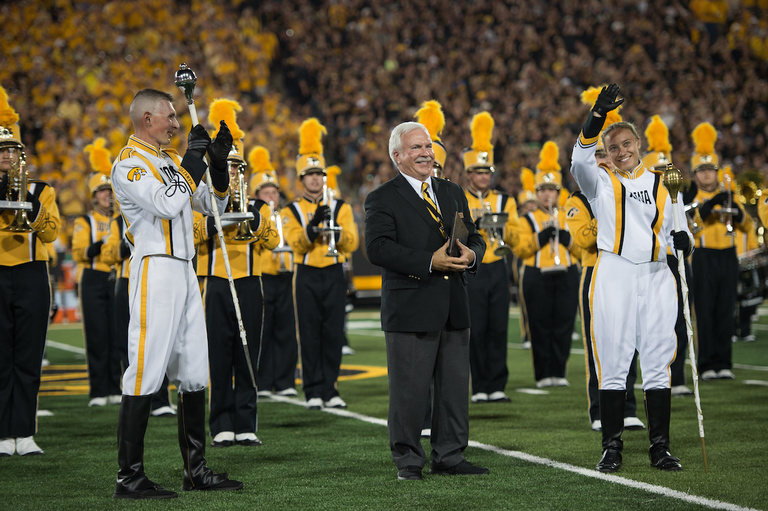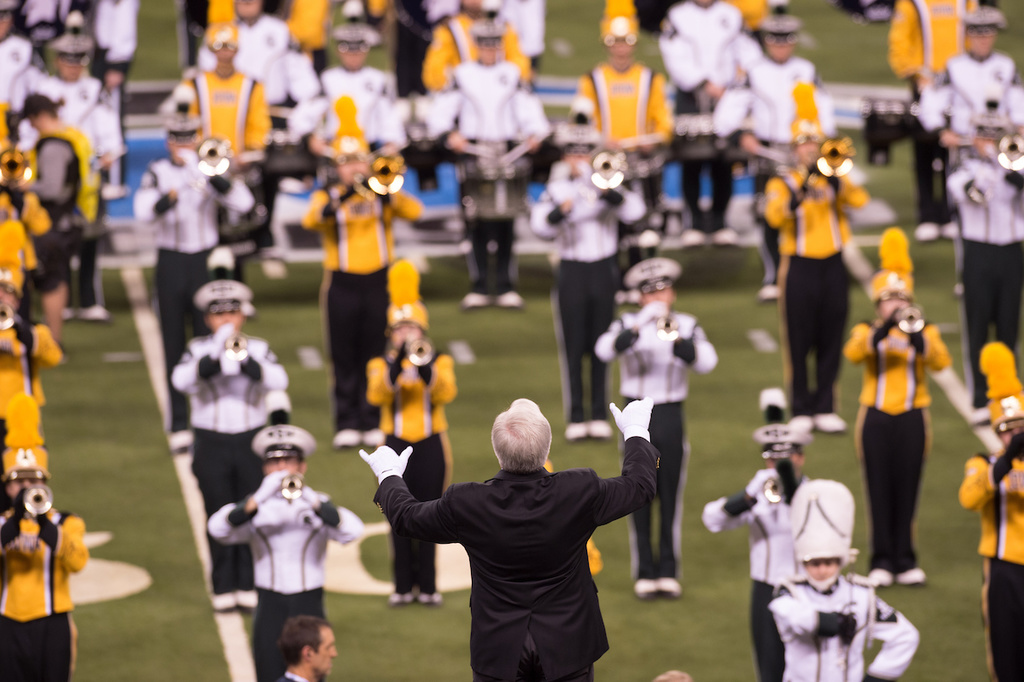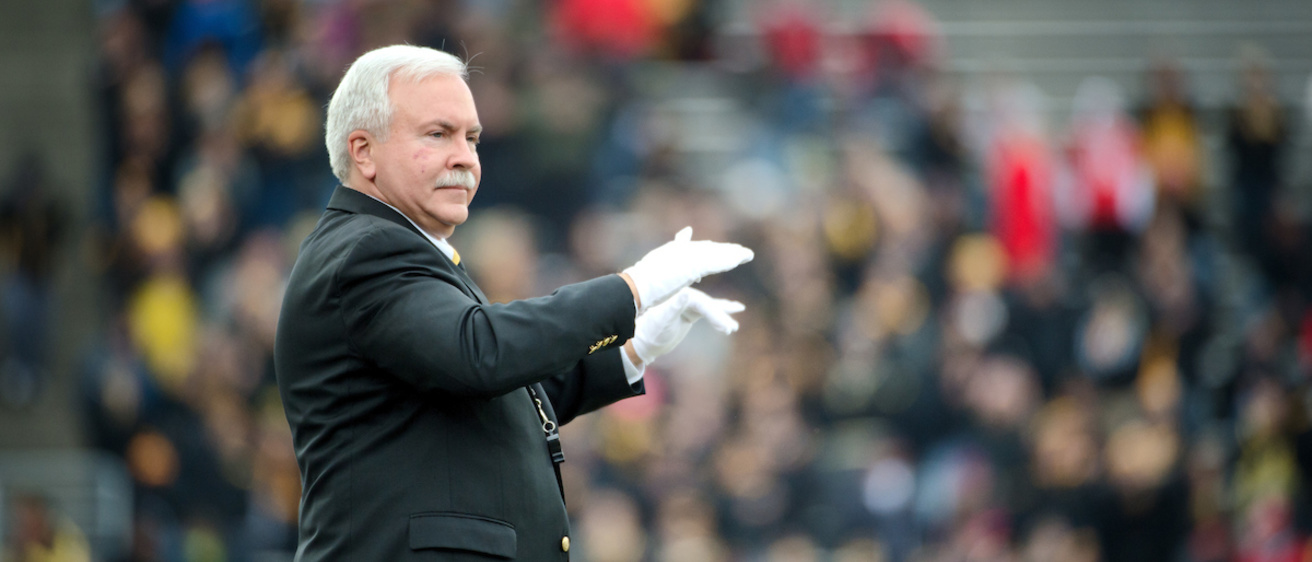Kevin Kastens’ love of marching band—particularly Big Ten marching bands—is evident in the fact that during 31 seasons, he has never missed a game.
“Sharing with students the thrill of performing in front of 70,000 fans is the best part of my job,” he says.
Kastens, associate director of bands and director of the Hawkeye Marching Band, has spent the past 40 years conducting high school and college bands, the last 20 years here at the University of Iowa. He has had an immense impact on the Hawkeye Marching Band and the UI School of Music: maintaining old traditions while adding new ones; finding the band a permanent practice facility; and developing software to design marching band routines.
And, for himself and countless others, he’s created decades of memories.
To the Big Ten and back again
It was an influential high school marching band director who sparked Kastens’ initial interest in directing marching band himself—particularly at the high school level. That interest turned to the college level after Kastens marched and served as a graduate assistant under Gary Smith, director of the Marching Illini at the University of Illinois.
Kastens spent nine years honing his craft at high schools in suburban Chicago before making the leap to college, spending six years as assistant director of bands and assistant director of marching band at Indiana University in Bloomington, Indiana. There, he wrote all the drills for the marching band and directed the pep band during a high point in Indiana basketball.
“I like to say I played for Bobby Knight,” Kastens jokes. “But what a great start to a college career, starting at a Big Ten university.”
Kastens got the opportunity to take over his own band at the University of Missouri, serving as associate director of bands and director of the Marching Mizzou. His many honors while at Missouri included becoming the first director to be inducted by marching band members into the Marching Mizzou Hall of Fame and being elected Faculty Member of the Year by the student organization Mizzou Spirit.
When the chance to return to the Big Ten presented itself, Kastens says he couldn’t pass it up. He was hired at Iowa in 1998 and hasn’t been tempted to leave since.
“There isn’t a better job than Iowa,” Kastens says. “This is an opportunity to be the director of a marching band in a Big Ten school. What’s better than that?”
Kastens’ experience, both musically and with the Big Ten, made him stand out from other applicants.
“He was deeply immersed in what the Big Ten meant and what marching band means in the Big Ten,” says David Gier, director of the UI School of Music, who was a member of the search committee that offered Kastens the job. “But his distinguished career as a high school band director was also important to us because, in addition to being director of the Hawkeye Marching Band, he would also fulfill the important role of conducting the concert band and teaching courses. So, we were looking for someone who not only had the chops as a marching band director at the highest level but who also could add to our curriculum as a conductor and educator.”
Respecting tradition while putting his unique stamp on the program
Kastens oversees a marching band that traces its roots back to the late 1800s.
“There’s a lot of responsibility as a marching band director in the Big Ten,” Kastens says. “There are great traditions both musically and visually—you think of the script ‘Ohio,’ the distinct visual style of Wisconsin, the block ‘M’ for Michigan. We have the Iowa and Hawks formations, and I added the Tigerhawk during the pregame show; that was my contribution. I’m honored to have had the opportunity to maintain and maybe enhance the Iowa tradition.”
Kastens’ colleagues agree he has been an excellent caretaker of Hawkeye Marching Band tradition while also putting his own stamp on the program. Two things tend to come up over and over when talking about the legacy Kastens will leave: Establishing a program that represents the values of the UI and developing an esprit de corps.
“Kevin has established a great culture within the band,” Gier says. “I realize that when some people think of music at the University of Iowa, they think of the Hawkeye Marching Band first, foremost, and maybe only. So, I’m really so happy that Kevin has made the band such an exemplary organization that we can all be proud of.”
Mark Heidel, director of bands and professor of music in the UI School of Music, appreciates Kastens’ leadership in making the marching band an organization that represents the university so well.
“He sets high expectations, from the language students use to their behavior before rehearsal or while they’re in uniform,” Heidel says. “And there are consequences for breaking these rules. These are young people who at times make poor decisions, but he’ll follow up and make sure they understand the expectations and the tradition they represent.”
Drum major makes Hawkeye Marching Band history

“You never hear anything embarrassing about the marching band,” says Charlie Taylor, associate athletics director for strategic communications and marketing. “They are one of the front doors to the university, and you can always count on them to always represent us well, whether at home or on the road.”
At 260 members, the Hawkeye Marching Band is one of the largest student groups on the UI campus, and band members represent 53 majors. In fact, only 12 percent are music majors.
“Most of these students started playing an instrument in fifth grade,” Kastens says. “They may not want to do it for a living, but they love playing. They don’t do it for the credit hour or easy ‘A.’ They do it for the camaraderie and playing for Hawkeye football in Kinnick Stadium.”
It’s this culture around the Hawkeye Marching Band that Gier says brings band alumni back to campus years later.
“They join this close-knit community in which they make friends and build up their social network,” Gier says. “They become Hawkeyes deeply because of this experience, and it makes a huge impression on them, with some giving back to the university based on the experience they had in the marching band.”
Heidel points to the 2016 Rose Bowl as evidence.
“There was something magical about that trip,” Heidel says. “The band worked so hard, and they were all working toward the same goal. They played with a lot of pride. They were so proud to represent their team, their university, and their state. And they were having fun. I’ve never been as proud of the band as I was at the Rose Bowl.”
Another area on which Kastens made his mark, not only at the UI but in the field as a whole, was incorporating new technology into marching band drill design. The formations that marching bands create on the field were traditionally crafted by hand using graph paper, protractors, and compasses.
Myron Welch, professor emeritus and director of bands at the UI when Kastens was hired, says the marching band director was ahead of his time when it came to leveraging technology to help choreograph performances and arrange music.
Kastens assisted in the beta testing and development of an early drill-writing software program.
“My first computer drill was done on an Apple IIe,” Kastens says. “I’ve gotten to see the evolution of that software, and now it’s just amazing what you can do.”
Cultivating a relationship with athletics and finding the band a home
Most Hawkeye fans would agree the team on the field or on the court isn’t the only entertainment on game day.
“The band is a big part of the DNA of Hawkeye football and basketball. You don’t have a game without the band,” says Taylor, who also served as the Hawkeye Marching Band drum major from 1994 to 1995. “It’s part of the fabric of everything we do on game day.”
Gier says it’s obvious that the marching band’s performance is a must-see part of a football game.
“One of the coolest things for me is to look up in the crowd at halftime and see everyone still sitting,” Gier says. “They aren’t running to the bathroom or to the concession stand. They’re watching the band—and not just the season ticket holders but the students as well. It says a lot about the experience Kevin has created for fans.”
There are a lot of moving parts to game day—and even more when traveling is required.
“He has an excellent rapport with the athletics department, which is absolutely necessary,” Welch says. “There’s so much coordination that has to happen, what we call ‘game day management.’ When do you enter the stadium? When do you perform? When do you trade times with the spirit squad or HawkVision? He’s able work with athletics to make that run smoothly.”
Students also recognize Kastens’ extraordinary organizational skills.
“Everything always runs smoothly,” says Analisa Iole, the band’s drum major and a senior from Marshalltown, Iowa, studying human physiology. “I’ve never experienced many hitches, if at all. And if there are tiny ones, he doesn’t make it known.”
In 2014, the Hawkeye Marching Band found a permanent practice space within a new UI multipurpose facility. The space includes indoor and outdoor practice fields, acoustic panels to enhance sound, and storage for instruments and uniforms. Along with serving as rehearsal space, the facility also houses recreational and club sports and provides training space for some athletic programs.
Gier and Welch say it’s in part due to the trust and goodwill that Kastens built with the athletics department that made the facility happen. Before that, the band rehearsed in a field along Park Road.
“It’s fantastic. We’re in our fourth season, and we’ve never had to cancel a rehearsal. Students initially really appreciated the bathrooms. And thanks to the storage, they no longer have to carry their instruments around,” Kastens says. “A few college band directors who have visited have been knocked out by this facility. And it’s great to see students who visit, particularly those from Minnesota, to see their eyes light up when you tell them there’s an indoor practice facility.”
A generous teacher
It might be easy to think you know everything about Kastens’ role at the UI by what you see at Kinnick Stadium on Saturdays. But there’s an academic component that most of the 70,000 fans don’t see, including his work in the classroom and with the concert band.
“What people don’t necessarily know is that Kevin is a fine teacher,” Welch says. “He’s very generous with his time, and there’s nothing more valuable than one’s time.”
Welch says that though this holds true for all of Kastens’ students, it’s particularly apparent at the graduate level. Every season, Kastens allows his graduate assistants to each design a show, rehearse it, lead it during a game, and record it for their portfolio.
“The fact that he gives up the reins and lets other people have this opportunity in this formative part of their career is really appreciated by the graduate staff,” Welch says. “It also helps us attract grad students to the department because they know they’ll get opportunities that they won’t get at many other places.”
Gier says Kastens is a quiet but persistent advocate for students and the experience they have during their time at the UI, and his interest in helping them develop leadership skills makes them very marketable after graduation.
“Many fine institutions are confident in hiring our students because they know they are battle-tested,” Gier says.
Alyson Krapfl, a senior from Ely, Iowa, working toward her music therapy degree, also notes Kastens’ enthusiasm for teaching. A piccolo player in the marching band, she says a moment during the Tournament of Roses Parade particularly sticks out in her mind.
“We were at about the fourth mile (of the 5.5-mile parade) and we were all getting tired,” Krapfl says. “But he was cheering us on and reminding us to get those knees up, telling us we could do it and to keep going.”
One trait that Heidel says he’s always appreciated about Kastens is his insistence on putting student welfare above everything else, including the quality of a performance.
“It was raining before a pregame rehearsal earlier this season, and even though there was a chance the rain would stop during rehearsal, rather than take that chance, Kevin had students leave their instruments in their cases and simply walk through the routine,” Heidel says. “Even though it was an important performance, he was willing to sacrifice that last rehearsal and avoid taking the chance that an instrument might get damaged.”
20 years of Hawkeye memories
Over the course of 170 game day performances, Kastens has about seen it all—especially in terms of weather. But a few games stand out, including Sept. 3, 2011, when the game was delayed and the stadium temporarily evacuated due to lightning during a torrential rainstorm.
“The band was in the team tunnel, but I remember the water cascading down the stands like a waterfall,” Kastens says.
He also points to the 2015 game against Purdue, in which heavy snow required staff to continually clear the field overnight. Though the stands were full of snow at game time, the field looked like any other fall day.
Kastens says he was always respectful of the variety of musical tastes in Kinnick Stadium, trying to pick music that would appeal to everybody at least one game each season.
“But rock bands that use a lot of brass always make for great shows,” Kastens says.
And while he says it’s hard to pick favorites, performing Michael Jackson’s “Thriller” always got a great crowd response.

Passing the baton
Along with the seniors on the Iowa football team, the crowd in Kinnick Stadium on Saturday will say goodbye to 41 seniors in the Hawkeye Marching Band. And then there’s Kastens, who, after 171 Hawkeye football halftime performances, will step on the field at Kinnick Stadium for the final time. He will retire in the spring.
“I don’t think it’s hit me quite yet,” Kastens says.
Everyone agrees that Kastens will leave pretty big shoes to fill.
“Kevin does it all, and we can always count on him,” Gier says. “He’s going to be missed.”
Kastens says he’s grateful to have participated in a Big Ten championship game and the Rose Bowl, “including the parade, which is just as important as the game for the band.”
His only regret? Not getting to a national championship game.
“That would have been fun,” Kastens says. “Hopefully that will be the next director.”
